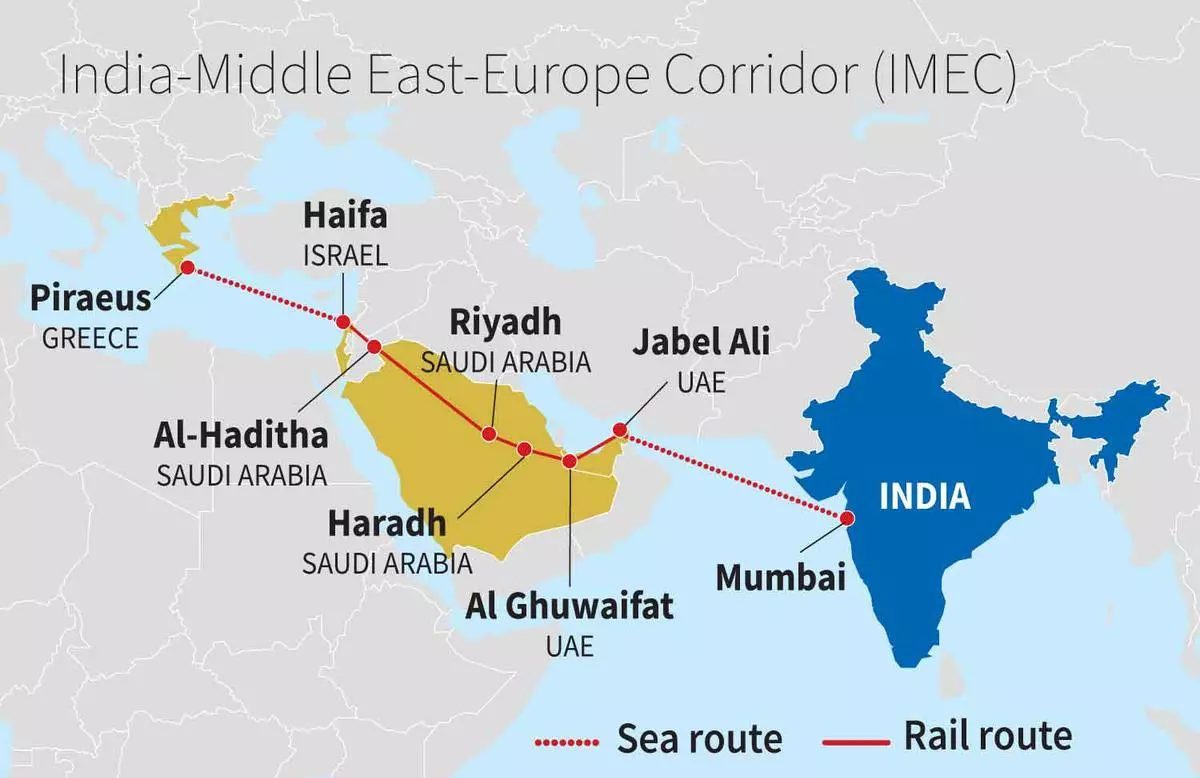Introduction
In an era where connectivity defines power, the India–Middle East–Europe Economic Corridor (IMEC) emerged as a visionary project connecting India’s western ports with Europe via the Arabian Peninsula. Envisaged as a multi-modal corridor encompassing maritime, rail, energy, and digital infrastructure, IMEC sought to integrate economies across continents while promoting peace and prosperity in a historically volatile region.
However, the optimism that surrounded IMEC’s launch quickly met the harsh reality of geopolitics. The October 7 Hamas attacks and subsequent Israel–Gaza war exposed the fragility of West Asian stability, placing IMEC’s implementation in question. Yet, beyond the uncertainty lies an opportunity for India to reshape its connectivity vision, adapting routes and partnerships to new global dynamics.
Why in the News
The IMEC has resurfaced in policy discussions as its viability faces uncertainty amid the deteriorating West Asian security environment. The October 7 Hamas–Israel conflict disrupted regional optimism nurtured by the Abraham Accords and slowed progress on IMEC’s proposed transnational links. At the same time, climate-driven Arctic trade routes and Red Sea disruptions by the Houthis are redrawing global shipping patterns, forcing India and its partners to reconsider IMEC’s configuration. The issue is critical as the corridor represents both an economic and strategic counterweight to China’s Belt and Road Initiative (BRI).

The Strategic Vision Behind IMEC:
- Comprehensive Connectivity: IMEC aims to upgrade maritime routes between India and the Arabian Peninsula and establish high-speed rail links from UAE ports to Haifa, Israel, via Saudi Arabia and Jordan.
- Integration with Europe: From Haifa, goods would be shipped to Europe’s Mediterranean ports, ensuring faster, secure, and sustainable trade connectivity.
- Beyond Transport: The corridor also includes plans for a clean hydrogen pipeline, electricity cable, and high-speed undersea digital cable, linking energy and digital ecosystems across three continents.
- Strategic Objective: IMEC provides a non-Chinese, rules-based alternative to the Belt and Road Initiative (BRI), enhancing India’s strategic outreach and economic influence.
The Geopolitical Context of 2023:
- Favourable Climate: The Abraham Accords (2020) created optimism for regional peace, bringing Israel and several Arab states closer. This atmosphere facilitated multilateral cooperation frameworks such as I2U2 (India, Israel, UAE, U.S.), paving the way for IMEC.
- India’s Upward Trajectory: India’s improving ties with Saudi Arabia and the UAE, coupled with strong U.S. relations, allowed it to play a central role in IMEC’s conception.
- Global Endorsement: The corridor was launched at the G-20 Summit in Delhi, with support from the EU, France, Germany, Italy, and Saudi Arabia, underscoring India’s emergence as a trusted global partner.
The Security Setback and Regional Volatility
- Conflict Shock: Within weeks of IMEC’s announcement, the Hamas–Israel conflict erupted, reversing the post-Abraham optimism.
- Regional Fallout: Israel’s military operations strained ties with Arab countries, undermining cross-border infrastructure cooperation.
- Red Sea Disruptions: The Houthi attacks on cargo ships forced rerouting via the Cape of Good Hope, increasing transit time and cost.
- Lesson: The events underscore that geopolitical stability remains the cornerstone of connectivity, and corridors like IMEC must remain adaptable to shifting realities.
Europe’s Changing Maritime Interests
- Arctic Openings: Climate change has opened new northern sea routes, shortening Asia–Europe shipping times. Beneficiaries include Russia, the U.S., China, and northern European nations.
- Mediterranean Anxiety: Countries like Italy, dependent solely on the Mediterranean, fear economic marginalisation if Arctic routes dominate trade.
- Strategic Importance of IMEC: Hence, Mediterranean states see IMEC as a means to sustain their maritime relevance and diversify trade partnerships.
- India’s Role: For India, the Mediterranean remains vital, as Arctic routes offer no immediate logistical advantage.
Why IMEC Still Matters for India
- Economic Scale: With $136 billion in annual trade, the EU remains India’s largest trading partner, highlighting the need for resilient connectivity.
- Supply Chain Resilience: IMEC offers a secure, shorter route connecting India to Europe while reducing dependence on the Red Sea–Suez chokepoint.
- Strategic Leverage: Enhanced engagement with Arab economies can dilute Pakistan’s influence and integrate India deeper into West Asia’s economic architecture.
- Innovation Space: As a multi-member initiative, IMEC allows India to propose new routes via Saudi Arabia and Egypt, adapting to political flux.
Challenges and the Way Forward
- Security Dependencies: Ongoing instability in Gaza and Israel poses a persistent threat.
- Financial and Political Coordination: Multi-country infrastructure projects face coordination delays, regulatory inconsistencies, and funding constraints.
- Need for Parallel Efforts: India must also upgrade domestic ports and logistics infrastructure, including Sagarmala and Dedicated Freight Corridors, to complement IMEC.
- Diplomatic Continuity: Sustaining dialogue through I2U2 and G-20 cooperation can help preserve IMEC’s spirit even if its routes evolve.
Conclusion
The IMEC’s future will depend not merely on the pacification of West Asia but on the political agility and diplomatic imagination of its members. While the corridor’s physical routes may shift, its strategic essence remains intact, to build resilient, diversified, and sustainable connectivity between India and Europe. For India, IMEC is more than an infrastructure project; it is a statement of intent, to be at the centre of global supply chains and a stabilising power in a fractured world.
PYQ Relevance
[UPSC 2018] The China-Pakistan Economic Corridor (CPEC) is viewed as a cardinal subset of China’s larger ‘One Belt One Road’ initiative. Give a brief description of CPEC and enumerate the reasons why India has distanced itself from the same.
Linkage: While China’s CPEC runs through disputed territory, making India wary, the IMEC shows how India is building its own clean, safe, and cooperative route to connect with Europe. It’s India’s way of staying in the global connectivity game—on its own terms.
Get an IAS/IPS ranker as your 1: 1 personal mentor for UPSC 2024

